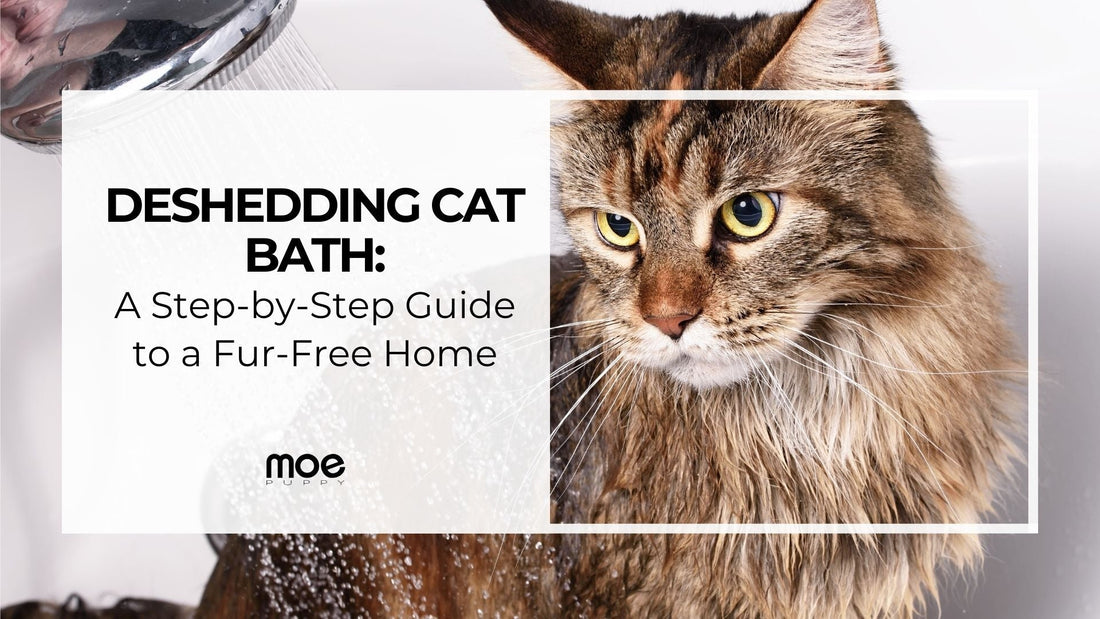
Deshedding Cat Bath: A Step-by-Step Guide to a Fur-Free Home
Share
Is your home starting to resemble a fur factory, with cat hair on every surface? You're not alone. Many cat owners face the challenge of managing shedding, especially during seasonal changes. While cats are meticulous groomers, sometimes they need a little extra help to keep their coats in top condition. One effective method is the deshedding cat bath. In this guide, we'll walk you through the process, ensuring both you and your feline friend have a stress-free experience.
Understanding Cat Shedding
Shedding is a natural process for cats, allowing them to remove dead hair and make way for new growth. However, excessive shedding can be a sign of underlying health issues or environmental factors. It's essential to monitor your cat's shedding patterns and consult a veterinarian if you notice significant changes.

Why Do Cats Shed Excessively?
There are several reasons why cats may shed more than usual:
- Seasonal Changes: Cats often shed more in the spring and fall.
- Stress and Anxiety: A stressed cat may lose more fur than normal.
- Poor Nutrition: A lack of essential nutrients can lead to excessive shedding.
- Medical Issues: Conditions like allergies, parasites, or infections can contribute to hair loss.
Benefits of Regular Bathing
While cats are known for their self-cleaning habits, occasional baths can offer several benefits:
- Reduces Shedding: Bathing helps remove loose hair before it ends up on your furniture.
- Improves Skin Health: A clean coat reduces the risk of skin infections and irritation.
- Enhances Coat Appearance: Regular baths can make your cat's fur look shinier and feel softer.
Choosing the Right Shampoo
Selecting the appropriate shampoo is crucial for your cat's skin and coat health. It's recommended to use a shampoo specifically formulated for cats, as their skin has a different thickness and pH than human skin. Human shampoos, including baby shampoos, can be too harsh for them. A hypoallergenic shampoo without added perfumes is ideal for routine bathing. (vcahospitals.com)
One product to consider is the Keratin+ Hairfall Shampoo for Dogs & Cats. This shampoo is enriched with essential proteins like Biotin and Collagen, which nourish, repair, and strengthen fur from the inside out. Regular use can help reduce excessive shedding and improve overall skin and coat health.
Preparing for the Cat Bath
Preparation is key to ensuring a smooth bathing experience:
- Gather Supplies: Have the cat-specific shampoo, a cup for rinsing, towels, and a non-slip mat ready.
- Brush Your Cat: Before the bath, gently brush your cat to remove loose hair and detangle any knots.
- Choose the Right Time: Select a time when your cat is calm, perhaps after a meal or play session.
Step-by-Step Guide For Your Cat Bath
- Fill the Tub: Use a sink or bathtub with a few inches of warm water.
- Wet the Coat: Gently pour water over your cat, avoiding the head area.
- Apply Shampoo: Massage the shampoo into the fur, starting from the neck down to the tail.
- Rinse Thoroughly: Ensure all shampoo residues are washed out to prevent skin irritation.
- Dry Your Cat: Wrap your cat in a towel and gently pat dry. Avoid using hairdryers as they can be too loud and hot for cats.
Also Read: 4 Tips To Keep Your Cat Healthy And Happy
How to Dry Your Cat Properly
- Use a Soft Towel: Gently press the towel against the fur to absorb moisture.
- Let Them Air Dry: If your cat tolerates it, allow them to air dry in a warm, draft-free room.
- Brush Once Dry: Once completely dry, brush again to remove any remaining loose fur.

Post-Bath Care
After the bath:
- Brush Again: Once your cat is dry, give them another gentle brush to remove any remaining loose hair.
- Reward Your Cat: Offer treats or playtime to associate bath time with positive experiences.
Addressing Cat Hair Fall and Loss Patches
If you notice bald spots or excessive hair loss, it could be due to various reasons, including allergies, parasites, or stress. It's essential to consult with a veterinarian to determine the underlying cause and appropriate treatment. (bestfriends.org)
Dietary and Nutritional Factors
A well-balanced diet plays a significant role in coat health. Ensure your cat gets:
- Omega-3 and Omega-6 fatty acids for healthy skin.
- High-quality protein to support strong fur growth.
- Adequate hydration to prevent dry skin and excessive shedding.
Tips to Minimize Shedding
Beyond regular baths, consider the following:
- Regular Brushing: Depending on your cat's breed, brush them several times a week to remove loose hair.
- Healthy Diet: Ensure your cat receives a balanced diet rich in essential nutrients to promote a healthy coat.
- Hydration: Proper hydration supports skin health and reduces shedding.
When to Consult a Veterinarian
If your cat's shedding is accompanied by other symptoms like itching, redness, or behavioral changes, it's crucial to seek veterinary advice. Early detection can prevent potential health issues from escalating.
Conclusion
Managing your cat's shedding doesn't have to be a daunting task. With regular deshedding baths, proper grooming, and attentive care, you can maintain a fur-free home and a happy, healthy feline companion.

